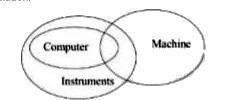Two statements are given, followed by three conclusions numbered I, II and III. Assuming the statements to be true, even if they seem to be at variance with commonly known facts, decide which of the conclusions logically follow(s) from the statements.
Statements:
All computers are instruments.
Some machines are computers.
Conclusions:
I.All instruments are computers.
II.Some machines are instruments.
III.Some instruments are machines.
Only conclusions II and III follow.
Only conclusions I and III follow.
All the conclusions follow.
Only conclusions I and II follow.
The correct Answer is:A

So, only conclusion II and III follows.
Similar Questions
Two statements are given, followed by three conclusions numbered I, II and III. Assuming the statements to be true, even if they seem to be at variance with commonly known facts, decide which of the conclusions logically follow(s) from the statements.
Statements: All women are engineers.
Some singers are engineers.
Conclusions: I. All women are singers.
II. All singers are women
III. Some engineers are women.
View SolutionTwo statements are given, followed by three conclusions numbered I, II and III. Assuming the statements to be true, even if they seem to be at variance with commonly known facts, decide which of the conclusions logically follow(s) from the statements.
Statements:
All drums are sticks.
Some drums are boxes.
Conclusions:
I. Some boxes are sticks.
II. Some sticks are drums.
III. All sticks are drums.
View Solution
Knowledge Check
Two statements are given, followed by three conclusions numbered I, II and III. Assuming the statements to be true, even if they seem to be at variance with commonly known facts, decide which of the conclusions logically follow(s) from the statements.
Statements:
I. All posters are pamphlets.
II. All envelopes are pamphlets.
Conclusions:
I. All pamphlets are envelopes.
II. Some pamphlets are posters.
III. Some posters are envelopes.AOnly Conclusion II follows.BConclusions I and II follow.CConclusions II and III follow.DOnly Conclusion III follows.Two statements are given followed by three conclusions numbered I, II and III.
Assuming the statements to be true, even if they seem to be at variance with commonly known facts, decide which of the conclusions logically follow(s) from the statements.
Statements:
Some phones are keyboards.
All phones are computers.
Conclusions:
I. Some keyboards are computers.
II. Some computers are phones.
III. No keyboard is computer.AOnly conclusion II follows.BOnly Conclusion I and II follow.COnly Conclusion I follows.DEither Conclusion I or III follows.Two statements are given, followed by two conclusions numbered I and II. Assuming the statements to be true, even if they seem to be at varience with commonly known facts, decide which of the conclusions logically follow(s) from the statements.
Statements :
All bats are sticks.
No strick is a ball.
Conclusions :
I. No bat is ball.
II No ball is bat.ANeither conclusions I nor II follows.BOnly conclusion I follows.COnly conclusion II follows.DBoth conclusions I and II follow.
Two statements are given, followed by three conclusions numbered I, II and Ill. Assuming the statements to be true even if they seem to be at variance with commonly known facts, decide which of the conclusions logically follow(s) from the statements.
Statements:
All photographs are newspapers.
Some photographs are computers.
Conclusions:
I. Some computers are photographs.
II. Some computers are newspapers.
Ill. Some newspapers are photographs.
View SolutionTwo statements are given, followed by the two conclusion numbered I and II Assuming the statements to be true. Even if they seem to be at variance with commonly known facts, decide which of the conclusions logically follow(s) from the statements.
Statements :
No plants is a tree.
All ornaments are plants.
Conclusions :
I. No ornaments is a tree
II. Some plants are ornaments.
View SolutionThree statements are given, followed by three conclusions numbered I, II and III. Assuming the statements to be true, even if they seem to be at variance with commonly known facts, decide which of the conclusions logically follow(s) from the statements.
Statements:
All hens are eggs.
All birds are eggs.
Some eggs are lions.
Conclusions:
I. Some lions are eggs.
II. Some eggs are hens.
III. Some eggs are birds.
View SolutionTwo statements are given, followed by three conclusions numbered I, II and III. Assuming the statements to be true, even if they seem to be at variance with commonly known facts, decide which of the conclusions logically follow(s) from the statements.
Statements:
I. All match-boxes are torches
II. All torches are lanterns.
Conclusions:
I. Some torches are match-boxes.
II. Some lanterns are match-boxes.
III. No match-box is lantern.
View SolutionTwo statements are given, followed by three conclusions numbered I, II and III. Assuming the statements to be true, even if they seem to be at variance with commonly known facts, decide which of the conclusions logically follow(s) from the statements.
Statements:
All cocks are bears.
All bears are horses.
Conclusions:
I. Some bears are cocks.
II. Some horses are cocks.
III. All cocks are horses.
View Solution
